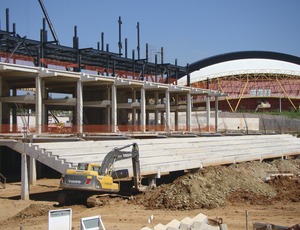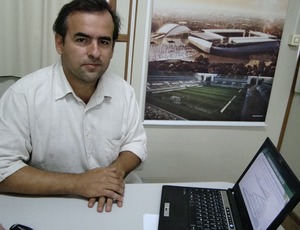

Brazil will have all 12 stadiums ready for the 2014 World Cup, say organizers in the host country, countering rumblings of doubt expressed by Fédération International de Football Association officials earlier this year.
Brasília's Sports Ministry did not inspire confidence after it issued a report this year that 40% of the projects were behind schedule. By May, FIFA bigwigs were bluntly skeptical about whether Brazil would be ready to host a tournament that is expected to draw 500,000 spectators from around the globe and pump billions into the economy. But Sports Minister Aldo Rebelo said contractors would meet the schedule.
Rebelo is also a key player in the run-up to the 2016 Rio Olympics. Speaking to reporters in London at the conclusion of the 2012 Games there, he said he was impressed with British planning and operations. Brazil hopes to convey in 2016 that it is a "tolerant and diverse and welcoming" country, he added.
 |
Pregame Show
Stadium construction programs remain on track, officials claim. A clue to that assessment's accuracy could come in mid-November, when FIFA reveals the host cities for the 2013 Confederation Cup, a prelude to the World Cup. Six venues have been preselected, but FIFA will name the four host cities this fall after assessing conditions.
Two of the finalist cities, Brasília and Recife, sport brand-new facilities. Salvador's government condemned its stadium after a section of the upper tier collapsed during a 2007 match, killing seven fans. The other three finalists—Belo Hoizonte, Fortaleza and Rio—feature rebuilt football arenas.
FIFA standards for World Cup venues are strict. For example, São Paulo's historic Estádio do Morumbi was rejected because its owners could not put in place financial guarantees for structural improvements to meet FIFA standards. As a result, the opening match will be played at a new $400-million, 65,800-seat venue currently under construction by Odebrecht S.A.
The final will be played in Rio's historic Maracanã stadium, where nearly 200,000 fans saw Uruguay upset Brazil 2-1 on July 16, 1958. The arena also will host the opening and closing ceremonies of the 2016 Summer Olympics. Although the capacity has been reduced to just under 77,000, it still will be the largest arena used for the 2014 World Cup.
The FIFA standards are high, but they do allow for flexibility and creativity. The São Paolo-based designer GCP Architetos modeled the Arena Pantanal to accommodate 42,000 fans during four World Cup matches. But after the games, Cuiabá, the Mato Grosso state capital with a population of about 500,000, would have little need for a facility so large. Working with London-based consultants Sinclair Knight, the team created a modular design that has four open corners to provide ventilation in a locale in which June daytime highs average between 85° F and 89° F.


Post a comment to this article
Report Abusive Comment